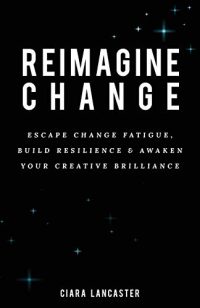My work often feels like it’s strangely disconnected; however, Reimagine Change: Escape Change Fatigue, Build Resilience, and Awaken Your Creative Brilliance connects two aspects of my world. Aspect number one is the work on change management. (See Confident Change Management for more.) The second aspect is burnout. (See Extinguish Burnout for more.) They connect and intersect in the ability to engage and motivate people, though change requires an ability to get people unstuck from burnout.
Reimagine Change is odd in that it sits somewhere between personal change and self-help book and organizational change management. Most books end up solidly on one side or another, but this one is one part of each with no clear weighting to either side.
Change Advocates
“Leaders at all levels are now expected to assume the role of change advocate.” I don’t know that I’d qualify this as “now.” I think leaders have always needed to be the facilitator of change. Leaders are, after all, leading somewhere. I do, however, think that there’s a greater awareness of the need for leadership and how it’s separate from position and a distinct discipline from management.
Here, Burns’ work, Leadership, and Rost’s work, Leadership for the Twenty-First Century, help to articulate the difference between someone who manages and someone who truly leads. We’re left with little doubt that leaders are changing themselves, those that follow them, and their organizations daily.

6R Model
Reimagine Change is built around a 6R model:
- REALISE your reality
- RESPOND via your capability
- RECLAIM your brain
- REGENERATE your body
- RECODE your mind
- REIMAGINE your creativity
I don’t know that these six are fully explored in the book, but many of them are reminiscent of the teaching we do with Extinguish Burnout.
Stress
Perhaps the biggest challenge I had with Reimagine Change came from the lack of precision around what burnout is, how it works, and the role of stress. I’ll freely admit that we’ve developed a highly consistent view of how burnout works and what it is and isn’t. Our work here is informed by an understanding of the work around learned helplessness (see The Hope Circuit for more) and, importantly, Spolsky’s work in Why Zebras Don’t Get Ulcers.
In short, stress is a payday loan. It’s short-term gain at the expense of long-term consequences. This necessarily reduces our long-term efficacy. This reduced efficacy makes us believe that we’re not making progress, which leads to learned helplessness and the feelings of inefficacy that characterize burnout.
When authors confuse stress (an indirect impact) as directly causal for burnout, I’m given great pause. While Lancaster is far from the only one to make this mistake, it’s concerning every time I see it.
Stressor Assessment
It’s concerning, because it fails to see the problem with enough clarity to enable folks to move forward. Consider, for a moment, stress itself. It’s considered a single thing, when, in reality, it’s not. We evaluate stressors for their probability and impact, and then we separately evaluate our capacity to overcome or mitigate the impacts of the stressor. The more resources we have directly or through our relationships, the less likely we are to see a stressor as stress inducing.
We experience stress when we’re concerned about our capacity to address the impact of a stressor. To be clear, it’s only when our capacity and the perceived impact are close that we develop a stress response. In cases like asteroids hitting the Earth, most of us don’t believe we have the resources to survive such a cataclysmic event, and therefore it rarely – if ever – creates stress for us.
Self-Awareness
What percentage of folks do you suppose are self-aware? Tasha Eurich is quoted as saying that 95% of people believe themselves to be self-aware when 10-15% of people actually are. Here, it’s tricky, because we’re all self-aware to some degree. We’re wired to have a self-perception of our body parts. It’s called proprioception, and it’s a part of us. More than that, we all know what colors and foods we like as well as a long list of things that we dislike.
The problem with such a broad-brush statement is that it’s treated as a binary response rather than the continuum that it is. I think a better statement would be that all of us should strive towards better self-awareness. This is something that even the Dalai Lama would agree is something that he works on. (See An Appeal to the World and The Dalai Lama’s Big Book of Happiness for more.)
Feelings Trump Facts
When it comes to who wins between the emotional elephant and the rational rider, it’s no contest. The rider believes they’re in control but discovers that the elephant gets its way when it really wants it. This is built on the elephant-rider-path metaphor that Jonathan Haidt first talked about in The Happiness Hypothesis and Dan and Chip Heath discussed in Switch.
The uptake of this is that our feelings, whether we like them or not, are really in control. If we want to make changes in our world, we’ve got to be willing to address our feelings as well as our thoughts.
Trauma
Everyone has trauma in their lives. We can either let it define us or we can work through it and work towards healing. Books like Opening Up and The Body Keeps the Score help us to see how trauma may be a fact of life, but it doesn’t have to be a life sentence.
Maybe if you want to find a way to change from your current place of being, whether personally or professionally, it’s time to Reimagine Change.



No comment yet, add your voice below!